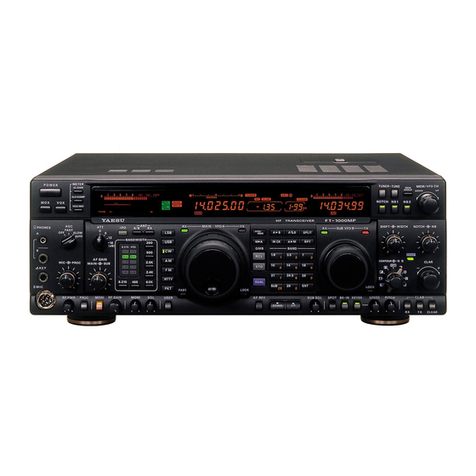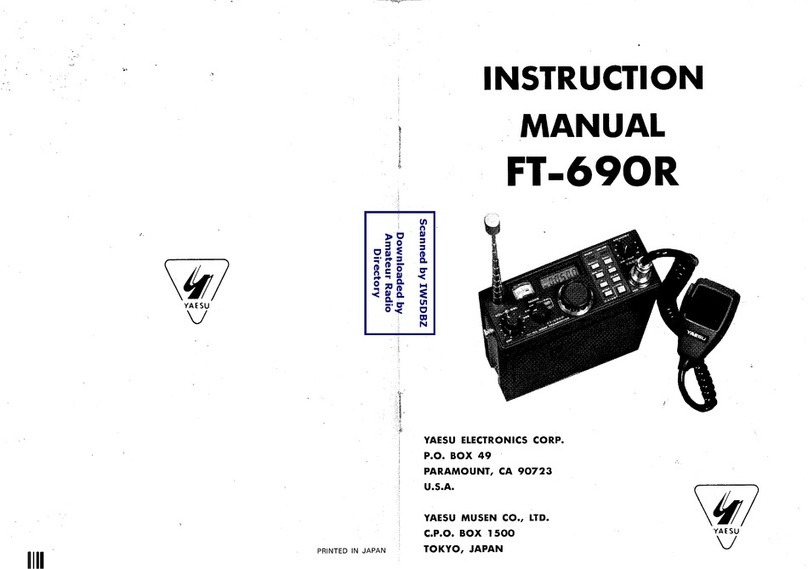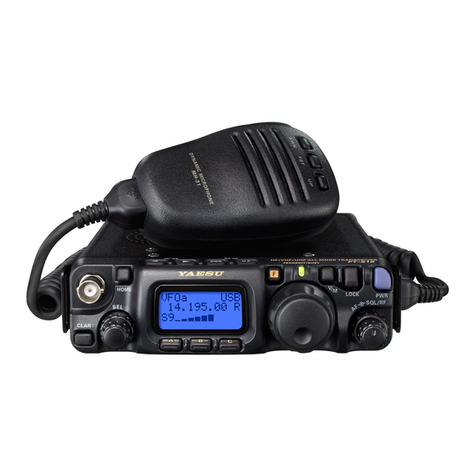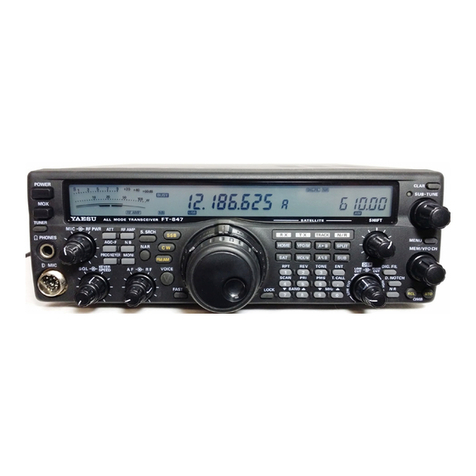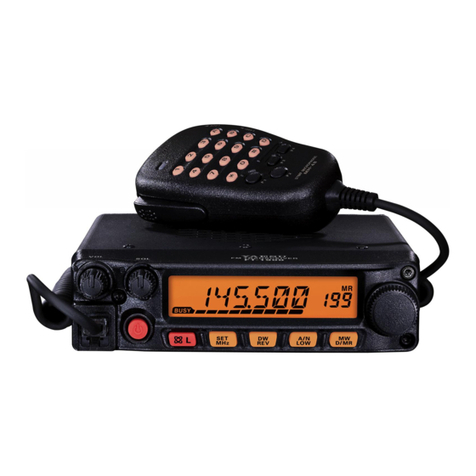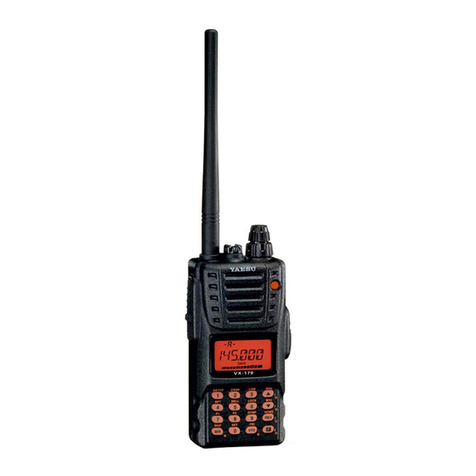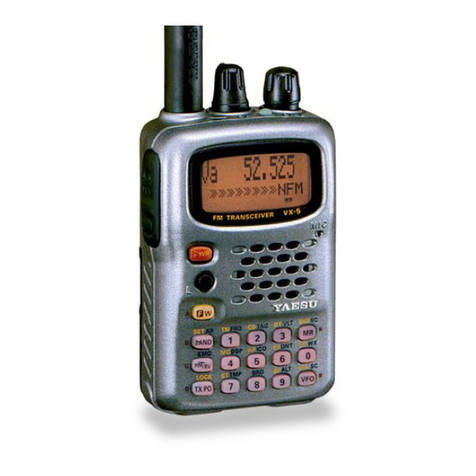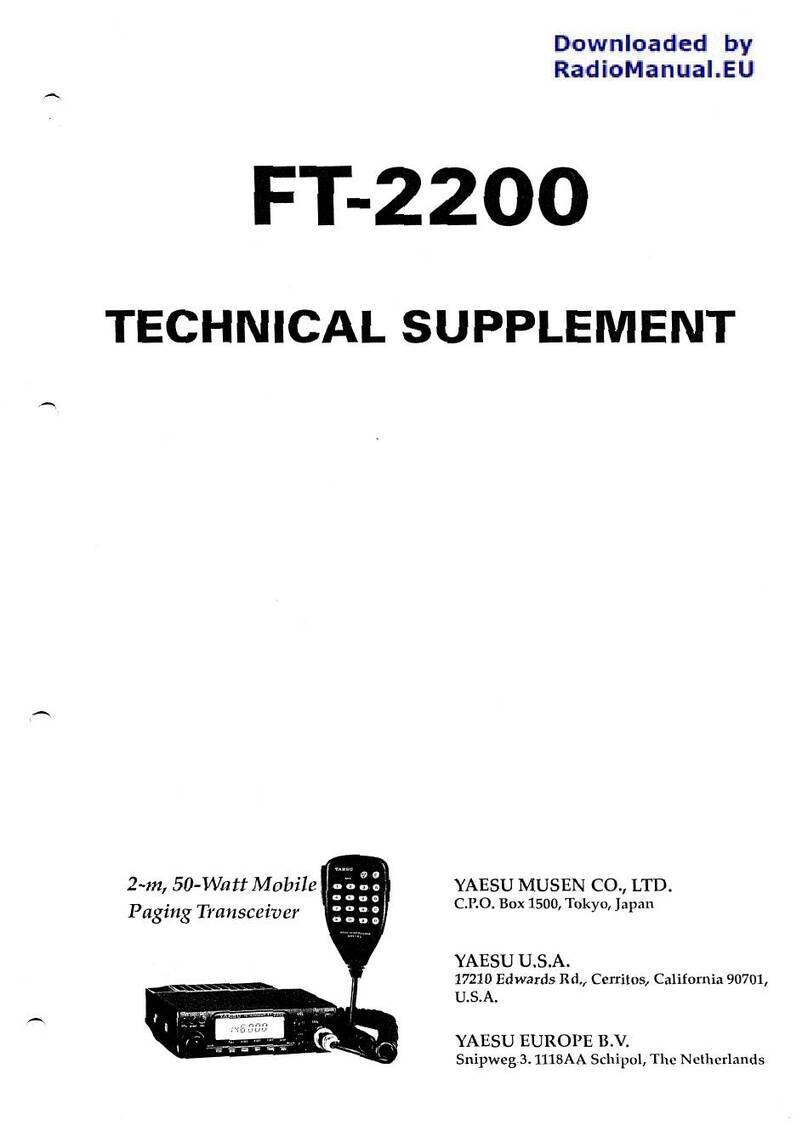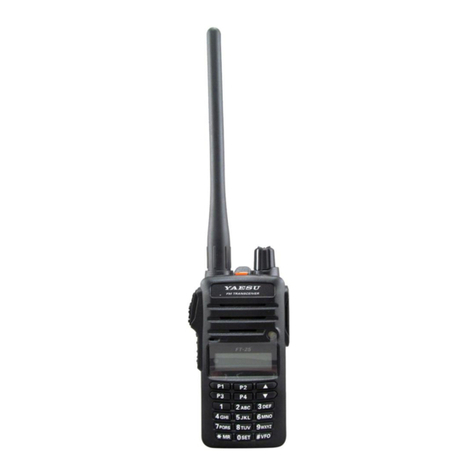
Contents
Scanning ..................................................................... 46
VFO Scanning ................................................................................
47
Setting the Squelch Level during activate Scanning Opertion
48
How to Skip (Omit) a Frequency during VFO Scan .............
48
Memory Scanning ..........................................................................
49
How to Skip (Omit) a Channel during Memory Scan ...........
49
Preferential Memory Scan ......................................................
50
Memory Bank Scan .................................................................
51
Programmable (Band Limit) Memory Scan (PMS) .....................
52
“Priority Channel” Scanning (Dual Watch) .................................
53
Automatic Lamp Illumination on Scan Stop ................................
54
Band Edge Beeper .........................................................................
54
Weather Alert Scan ........................................................................
55
Smart Search Operation ........................................... 56
Channel Counter Operation .................................... 58
EPCS (
Enhanced Paging & Code Squelch
) .................. 60
Storing the CTCSS Tone Pairs for EPCS Operation ....................
60
Activating the Enhanced Paging & Code Squelch System .........
61
Paging Answer Back .....................................................................
61
Emergency Feature ................................................... 62
Emergency Channel Operation .....................................................
62
Emergency Automatic ID (EAI) Feature .....................................
62
Selecting the EAI mode and its Transmit Time ....................
63
Activating the EAI feature ......................................................
63
To Locate an Unresponsive Operator Using the EAI Feature
64
ARTSTM (
Automatic Range Transponder System
) ...... 65
Sensor Mode ............................................................... 68
To display the Temperature ..........................................................
68
To display the Sensor Information ................................................
68
Selecting and Correcting the Atmospheric Pressure Meter ........
69
Selecting and Correcting the Altimeter ........................................
69
Internet Connection Feature .................................... 70
SRG (“Sister Radio Group”) Mode ..............................................
70
FRG (“Friendly Radio Group”) Mode .........................................
71
DTMF Operation ...................................................... 73
Manual DTNF Tone Generation ...................................................
73
DTNF Autodialer ...........................................................................
73
CW Training Feature ............................................... 75
Miscellaneous Settings .............................................. 76
Password ........................................................................................
76
Programming the “P” Key ............................................................
77
Receive Battery Saver Setup .........................................................
77
Wakeup Feature Setup ...................................................................
78
TX Battery Saver ...........................................................................
79
ATT (Front End Attenuator) .........................................................
79
Disabling the TX/BUSY Indicator ...............................................
80
Automatic Power-Off (APO) Feature ..........................................
80
Automatic Power-On Feature .......................................................
81
Busy Channel Lock-Out (BCLO) .................................................
82
Transmitter Time-Out Timer (TOT) .............................................
83
Changing the TX Deviation Level ................................................
83
Reset Procedures ....................................................... 85
Cloning ....................................................................... 86
Set (Menu) Mode ....................................................... 87
Specifications ........................................................... 104
“AUTO” Mode Preset Operating Parameters ..... 106
General Description .................................................... 1
Accessories & Options ................................................ 2
Controls & Connections ............................................. 3
Top & Front Panel ............................................................................
3
LCD ...................................................................................................
4
Side & Bottom Panel ........................................................................
5
Keypad ..............................................................................................
6
Installation of Accessories .......................................... 8
Antenna Installation ..........................................................................
8
Belt Clip & Hand Strap Installation ................................................
8
Installation of FNB-80LI Battery Pack ...........................................
9
Battery Charging ...............................................................................
9
Installation of FBA-23 Battery Case ............................................
10
Low Battery Indication ..................................................................
10
Interface of Packet TNCs ......................................... 11
Operation ................................................................... 12
Switching Power On and Off ........................................................
12
Adjusting the Volume Level .........................................................
12
Squelch Adjustment .......................................................................
13
Selecting the Operating Band .......................................................
14
Frequency Navigation ...................................................................
14
Transmission ..................................................................................
16
Changing the Transmit Power Level ......................................
17
Changing the Microphone Gain Level ...................................
18
AM Broadcast Reception ..............................................................
18
AM Aircraft Reception ..................................................................
19
FM Broadcast/TV Audio Reception .............................................
19
Advanced Operation ................................................. 20
Keyboard Locking .........................................................................
20
Adjusting the Keypad Beeper Volume Level ..............................
21
Keypad/LCD Illumination ............................................................
21
Changing the Channel Steps .........................................................
22
Changing the Receiving Mode .....................................................
22
RF Squelch .....................................................................................
23
Checking the Battery Voltage .......................................................
23
Repeater Operation ................................................... 24
Repeater Shifts ...............................................................................
24
Automatic Repeater Shift (ARS) ..................................................
24
Manual Repeater Shift Activation ................................................
25
CTCSS/DCS Operation ............................................ 27
CTCSS Operation ..........................................................................
27
DCS Operation ...............................................................................
28
DCS Code Inversion ......................................................................
29
CTCSS/DCS Bell Operation .........................................................
30
Tone Search Scanning ...................................................................
31
Split Tone Operation .....................................................................
32
Tone Calling (1750 Hz) .................................................................
32
Memory Mode ........................................................... 33
Memory Storage ............................................................................
34
Storing Independent Transmit Frequencies (“Odd Split”) ..........
34
Memory Recall ..............................................................................
35
Labeling Memories ........................................................................
35
Memory Offset Tuning ..................................................................
37
Moving Memory Data to the VFO ...............................................
38
Masking Memories ........................................................................
38
Memory Only Mode ......................................................................
38
HOME Channel Memory ..............................................................
39
Memory Bank Operation ...............................................................
40
Direct Memory Recall Channel ....................................................
42
Short-Wave Broadcast Station Memory Channels ......................
43
Weather Broadcast Channels ........................................................
44
VHF-Marine Channels ..................................................................
45
